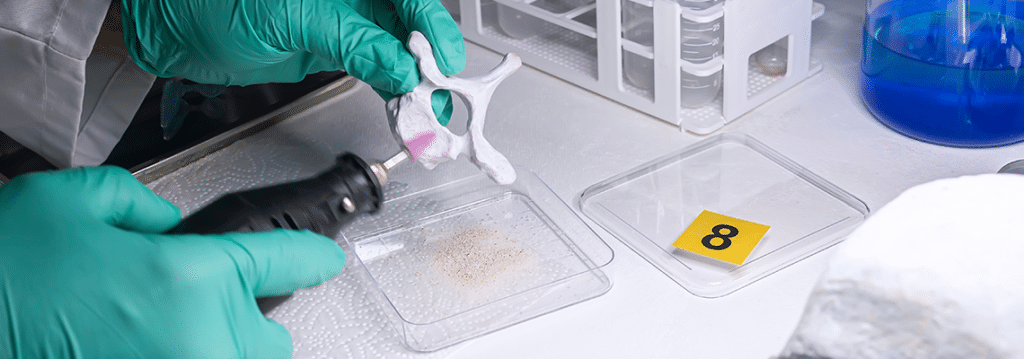
When Outsourcing is the Answer: The Best Tasks for Subcontracting
May 16, 2021
At InnoGenomics, our advice for forensic labs tends to follow a theme: make key investments in your staff and your lab, because outsourcing casework is not a long-term solution. So, you can trust us when we say that sometimes, outsourcing is actually the right way to overcome a backlog.
We still don’t recommend outsourcing the casework itself. That does nothing to help you prevent backlogs in the future. But this blog post covers some tasks that, when contracted to a team with specialized expertise, can build permanent capacity for your team to handle a higher throughput.
Optimizing Your Specimen Tracking
Long gone are the days of paper trails. Laboratory Information Management Systems (LIMS) have streamlined everything including how specimens are accessioned and tracked, how samples undergo processing with electronic worksheets, and how results are shared internally and externally.
Just because you have a LIMS, however, doesn’t mean that you’re maximizing its value. It’s important to ensure that your LIMS system is doing all the heavy lifting possible for your laboratory. Sgueglia advises labs to utilize features such as sample barcode tracking, reagent tracking, analyst assignments, sample processing, report writing and technical reviews to expedite laboratory workflow.
“If your LIMS system is cumbersome, integrating all the data you need for your workflow can be a difficult process,” said Sgueglia. “If your system hasn’t integrated components for every step of a process, then you are just adding additional steps and room for error to your workflow. A seamless incorporation of your LIMS system ultimately makes all processes and technical review much easier.”
An outside informatics expert can help you implement a new LIMS system; improve your institution’s existing system; or integrate new protocols, methodologies, and technologies. Outsourcing this task can be especially important for growing labs, as it can significantly increase efficiency.
Training New Staff
Training solutions can come in the form of a permanent change to staff members’ job descriptions (designated in-house trainer) or an as-needed contract with a third-party (e.g., NFSTC), Sgueglia says. It depends on your organization.
Two things are universally true:
- Adding staff can alleviate major backlogs, lessen the burden of a large workload on current employees, and improve the laboratory’s total workflow.
- To reach this bright future, extensive training needs to be undergone in accordance with your institution’s mandates (e.g., SWGDAM Training Guidelines).
In a lot of labs, training mandates mean senior analysts spend months training new hires. The expense of time, labor, and resources has the potential to immediately limit your throughput. Training leaves an even larger impact on labs with a high turnover or rapid expansion.
“One of the big issues that most labs experience, especially if they’re in a growth phase, is training,” said Sgueglia. “It’s always difficult in a case-working lab to have to take an analyst off casework to train new staff, especially if you don’t have a specific training program with designated staff.”
Sgueglia recommends committing specific resources and staff to training incoming employees—that’s the in-house solution. If that’s not an option for your lab, outsourcing training to third-party institutions might be the best option.
With academic institutions and companies offering training services in a wide range of principles and techniques, outsourcing your training procedures can be a simple way to eliminate bottlenecks in your laboratory.
Validating New Methodologies and Technologies and Automation Protocols
Constantly improving methodologies and technologies have the ability to streamline the workflow of some laboratories by forgoing outdated or inept processes in favor of newer, quicker, or more reliable procedures. But, as we all know, even the most minor changes to standard operating procedures require new validations to ensure their proper utilization in the laboratory.
Automating your lab’s techniques is a great example. Although automation can result in incredible savings in labor cost, increases in throughput and efficiency, and the elimination of human error, it requires a great deal of labor to fully integrate.
New methodologies and technologies still often require an analyst’s attention to get vetted for casework. But, as Sgueglia explains, DNA analysts don’t always have the skillset for performing validations or robotic experience for automation. As a result, validating new workflows has the potential to sideline analysts for months or years at a time, clogging up a lab’s productivity.
In our talk with Sgueglia, she relayed that outsourcing this work can be the right choice. When there is a need for laboratory expertise outside the purview of a trained DNA analyst, one can rely on personnel who are highly specialized in specific facets of laboratory operations. Contracting out this work to automation personnel, engineers, bioinformaticians, and other specialized staff is often the best solution.
InnoGenomics’ blog frequently includes insights on running an effective forensics DNA lab. To make sure you receive future news, subscribe to our newsletter below.

